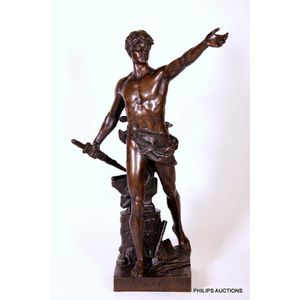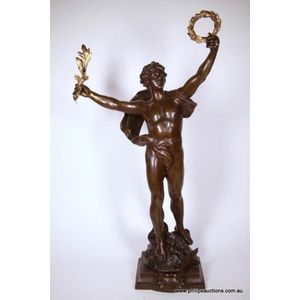Uriano: Art Deco Bronze Sculpture
You must be a subscriber, and be logged in to view price and dealer details.
Subscribe Now to view actual auction price for this item
When you subscribe, you have the option of setting the currency in which to display prices to $Au, $US, $NZ or Stg.
- Bronze - An alloy of copper and tin, traditionally in the proportions of about 9 parts of copper to 1 part of tin.
The discovery of bronze in Western Asia in the 4th century enabled people to create metal objects which were superior to those previoulsy possible because of its strength and hardness, and it has been used throughout the world for weapons, coins, tools, statuary and other decorative items.
It is very fluid in a molten state, and its hardness, strength when set, and non-corrosive properties makes it most suitable for casting sculpture. - Art Deco Period - The Art Deco period was a cultural movement that emerged in the 1920s and 1930s, and was characterized by its emphasis on modernism, luxury, and elegance. The name "Art Deco" comes from the Exposition Internationale des Arts Décoratifs et Industriels Modernes, a large exhibition held in Paris in 1925 that showcased the latest trends in decorative arts.
Art Deco was a reaction against the ornate and elaborate styles of the previous era, and reflected a new modern sensibility. It was characterized by streamlined, geometric shapes, bright colours, and the use of new materials such as chrome, glass, and Bakelite. Art Deco designers sought to create a sense of luxury and sophistication, often incorporating expensive materials such as ivory, marble, and rare woods.
Art Deco had a significant impact on a wide range of artistic fields, including architecture, fashion, graphic design, and interior design. Some of the most iconic examples of Art Deco architecture include the Empire State Building in New York City, the Hoover Building in London, and the Palais de Chaillot in Paris.
The Art Deco period came to an end in the 1940s, as World War II and changing cultural trends led to a shift in artistic styles. However, Art Deco remains an important influence on design and art, and continues to be celebrated for its modernist sensibility and glamorous aesthetic.
This item has been included into following indexes:
Visually similar items

A bronze figure, 'Devoir Civique' by Eugene Marioton (1854-1925), circa 1904, the majestic figure of a gesturing swordsmith standing by an anvil, the tools of his trade by his feet, title incised to the square base, incised signature, Eug. Marioton to the

A signed Art Deco spelter gazelle, circa 1920s, signed Limousin, a dramatically posed leaping gazelle in lustrous copper and bronze colours, raised on a cream marble base faced with brown and cream onyx, intaglio signature to spelter base, height 24.5 cm,

An Art Deco spelter antelope group by Limousin, circa 1930s, a pair of fleeing antelopes, one mortally wounded by an arrow, in bronze colours upon a veined black marble base faced with onyx, incised signature of Limousin to the reverse. Height 36.5 cm, wid

A spelter male figure of 'Le Triomphe' by Moreau, Louis Auguste (1855-1919), the heroic male figure in a classical stance with billowing girdled drapery, his left hand holding aloft a pair of gilded laurel garlands and in his right, a laurel branch; raised
